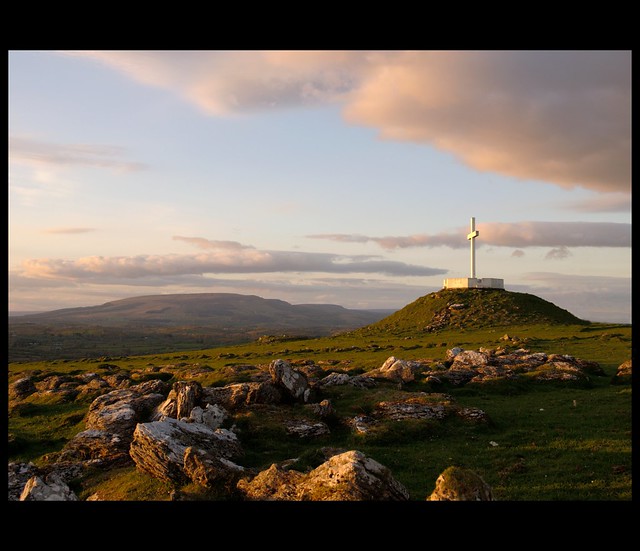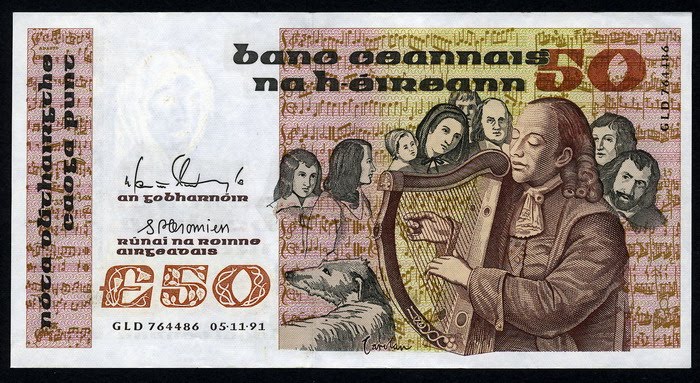Sí Bheag and Sí Mhor (Sheebeg and Sheemore) are two hills in Co.
Leitrim which are assoiated with the supernatural race, known as
sídhe or fairies.
'Sí Bheag Sí Mhor' is also the title of a beautiful harp tune,
written by the 17th century Irish harpist and composer Turlough
O'Carolan.
"In an account of his visit to the area in 1828, Edward O'Reilly
tells of two ranges of hills. On the highest part of one of the
ranges "is one of those ancient conical heaps of stones and earth
called motes or raths, so common in this country, and which the
popular voices says are inhabited by the Daoine Maithe, the "Good
People", which the country people dare not venture to call by the
name of fairies. This mote, and the mountain on which it stands,
are much celebrated in the popular poems and songs of Ireland under
the name of 'Sigh Mor'."

On the other range, near Squire Reynold's home was another mote,
'Sigh beg' [54° 00.780', N7° 57.726' - It can be seen to the
North-East from the cache location] which was also reputed
inhabited by fairies. According to local tales during the period in
which Fionn Mac Cubhail and Fianna Eirionn were defeated, one of
Fionn's heroes (perhaps Fionn himself), who was killed, was
entombed in Sigh beg and a warrior of the other side was buried in
Sigh mor. The battle of the two continued to be carried out by the
immortals of Sig beg and Sig mor."
Note: As with many Irish place names there are probably more
than 2 million different ways of spelling the names of these two
hills. However, they are all pronounced 'Sheebeg' and 'Sheemore'
(more or less).
To find out more about Geocaching in
Ireland visit the friendly & helpful Geocaching Ireland
discussion forum.
Turlough O'Carolan (Irish name Toirdhealbhach Ó Cearbhalláin)
was a blind, itinerant Irish harper and composer whose great fame
is due to his gifts for composition and verse. He is considered by
many to be Ireland's national composer and to have been the last of
the wandering Irish bards that moved from great house to great
house. He was also one of the last Irish harpers who composed and
luckily for us a significant number of his works survive in single
line melody.
O Carolan was was born in 1670 near Nobber, County Meath and
died March 25, 1738 at the home of his patron Mrs. MacDermott Roe
in Alderford, County Roscommon. He is buried 15 km from the cache
location at Kilronan Abbey, near Ballyfarnon, Co. Roscommon.
Carolan's father, John, moved his family to Ballyfarnon between
Lough Key and Lough Allen, when Carolan was fourteen years old to
take employment as a blacksmith with the MacDermott Roe family.
Mrs. MacDermott befriended the boy and gave him an education.
Around the age of 18 Carolan was blinded by smallpox.

O Carolan on the old Irish £50 note
Even before his illness Carolan had shown talent for poetry and
may have been taught, by a harper Named MacDermott Roe (possibly
Ruari dall who lived with the MacDermott Roes). Carolan studied for
three years more at the end of which Mrs. MacDermott Roe gave him a
harp, a horse and some money to begin his career as an itinerant
harper.
For the following forty-five years Carolan would travel
throughout Ireland playing his music in the last of the great
gaelic houses and composing many tunes (planxties) for his
patrons.
You'll find more information on O'Carolan and his music HERE, HERE
and HERE (some more staff notation).
'Sí Bheag agus Sí Mhor' is said to be the first tune Carolan
composed. After leaving Alderford at the age of 21, Carolan stopped
at Squire Reynold's house at Lough Scur. Mr. Reynolds, who had been
a harper and poet himself, was not apparently impressed by
Carolan's musical abilities and asked him if he composed. When
Carolan replied he did not, Squire Reynolds remarked he "might make
a better hand of his tongue than of his fingers." Reynolds planned
to leave a few days and suggested Carolan make a tune out of a
local legend of a "battle between the kings of the gentry
[fairies]." Upon his return Carolan had composed this tune.

You can listen to the tune by clicking the links below
(performed by Nick
Kroes)
Streaming Real Player Version (mono)
Streaming WinAmp / Windows Media Player Version (stereo) (if
you have a fast connection.)
You can also download the whole tune here.
This is a better sounding stereo MP3 file.
Right click and select 'Save Link as...' to save the file to your
computer.
